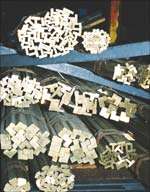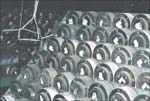The Case For Extruded Brass Shapes
Thanks to advances in extrusion technology, the old metrics for using near-net shaped brass stock are changing. The production advantages of extrusions are now more cost effective.
Let's start with some basics. All else being equal, it is faster and easier to machine a part from a near-net shape than to machine it from a solid chunk of metal. However, a near-net shape preform, such as castings, forgings and cold-formed parts, is usually formed in a die or mold, which must first be produced. Making the die or mold for the preform not only adds to the total production costs for the finished part but also increases lead time. For both reasons, preform use is usually reserved for parts produced in large quantities (hundreds of thousands to millions of parts), where the setup and tooling costs are more than offset by production cost savings, and long lead times are the norm.
There is, however, a near-net shape process that offers both relatively low tooling costs and fast turnaround times, making it possible for shops and manufacturing firms to reap the benefits of preforms for small as well as large part production runs. It's the brass extrusion process, and if you produce parts that are essentially 2D rather than 3D in nature and have a uniform cross section, you may want to explore its advantages for your company.
Featured Content
To learn about the advantages of using brass extrusions as the starting point for machined parts, we visited Chicago Extruded Metals Co. (CXM) (Cicero, Illinois), a brass mill that specializes in custom brass extrusions. The company started up in 1923 as a supplier to Chicago-area screw machining firms. As time went on, customers started asking more and more for extruded shapes instead of conventional round, square and hex barstock. Therefore, the company decided to specialize in that area.
Less Machining. Mark Sisson, marketing manager for the firm, and Frank Massa, director of sales, explained the advantages of machining parts from brass extrusions. They were quick to point out that although brass extrusions contain less metal per unit of length than a solid bar, they cost more per unit of length. The economy of using brass extrusions derives not from material cost savings, but from the reduced machining resources required to produce the finished part.
Because the required cross section of the part is produced in the extrusion process, machining usually consists of internal operations (drilling, tapping, countersinking, slotting) instead of roughing or shaping operations. Less machining means faster cycle times, permitting greater throughput on most machines. Less machining also means less tool wear, permitting machines to be operated for longer periods between tool changes.
"Many of our brass shapes are machined on rotary transfer and dial index-type machines," explains Mr. Massa. "We can incorporate a number of features in the design of the extrusion that would otherwise require a lot of machining stations to machine the part from solid bar. The whole idea is to machine the part completely on one machine without having to perform costly secondary operations on additional machine tools. Using a brass shape that can be completely machined in one setup also reduces work-in-process and handling costs for the part.
Combining Multiple Parts. Products that were formerly assembled from two or three separate components can be redesigned to be made from a single extrusion, eliminating the machining, inventory, handling and assembly costs for the separate components.
Fast Turnaround On Orders. Where the tooling for a brass casting or forging can take weeks or months to produce depending on the source, the company can deliver finished products in 2 to 4 weeks and faster deliveries are possible. The firm's in-house toolroom is equipped to cut the (EDM) electrodes, extrusion dies, straightening rolls and any other peripheral tooling needed to get into production. The toolroom has machining centers, but most of the work is done on wire EDM machines (to cut die openings) and ram-type EDM machines (to upsize and correct dies).
Suitable For Small Orders. CXM produces extrusion dies for orders as small as 2,000 pounds and will consider smaller orders depending on the long-range potential of the business. "Where years ago many of our customers would place an order for 10,000 pounds of brass shapes every month, now they're ordering 2,000 pounds every week," Mr. Massa says. "Our customers have to react to their customers who are ordering smaller quantities. We want to support our customers in their lean manufacturing initiatives."
Tailored Alloys. The company offers more than 20 brass alloys in the C30000 and C40000 series and has developed a number of variations designated as enhanced application alloys. "Our enhanced-application alloys are designed to enhance machining and/or improve tool life," Mr. Massa explains. "For example, one customer was having difficulty drilling concentric holes on his lathes because of chip buildup. So we modified the alloy to allow the chips to break more readily and exit the hole more freely. In such cases, we adjust the alloy within the ASTM standards to give the customer what he needs for optimal machinability."
"We are a mature industry," adds Mr. Sisson. "Many products, such as valves and locks, have been made from brass extrusions for years. However, the marketplace is becoming more demanding. Customers are requiring tighter dimensional tolerances, asking for sharper corners or a slight change in the alloy to improve tool life. In short, we're being asked to refine and improve jobs that have been around for years. And we're doing it."
Bars Or Cut Lengths. The company cuts 10 to 15 percent of its brass shapes into discrete parts on its battery of cold saws and are bulk shipped to the customer. "Many of our customers prefer cut pieces," Mr. Massa notes. "They may have older chuckers and dial index or rotary transfer machines that are set up for processing discrete parts. Although most of our customers still order their brass shapes in bar form, the marketplace is buying cut pieces as a means to reduce inventories, scrap and transportation costs. The resulting part can exceed conventional tolerances of castings and forgings, providing precise fixturing and locating surfaces."
Design Help. Mr. Massa notes that fewer companies today take advantage of CXM's metallurgical and extrusion design expertise. He acknowledges that many of his company's customers are experts when it comes to brass and brass extrusions. Nevertheless, he urges customers to consider CXM—and other material suppliers—as resources to tap before committing to material or form. "A lot of times, we're simply asked to quote the part after the design has been finalized," he notes. "Metalworking firms should communicate with their raw material suppliers in the part design stage, working together to come up with an ideal part from both the raw material and the processing sides."
You may never have an application for a brass extrusion. On the other hand, the next time a brass job comes along that involves machining away most of the metal to produce a part with a uniform cross section along its length, it may pay you to think shapes instead of chips.







